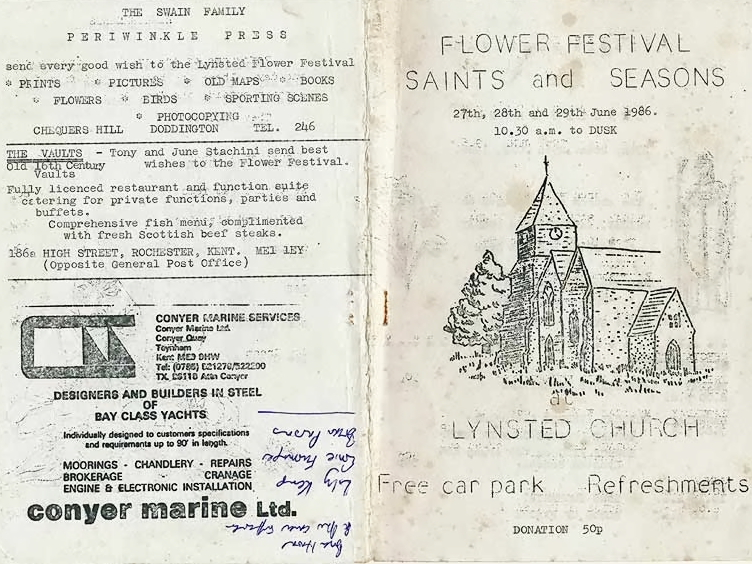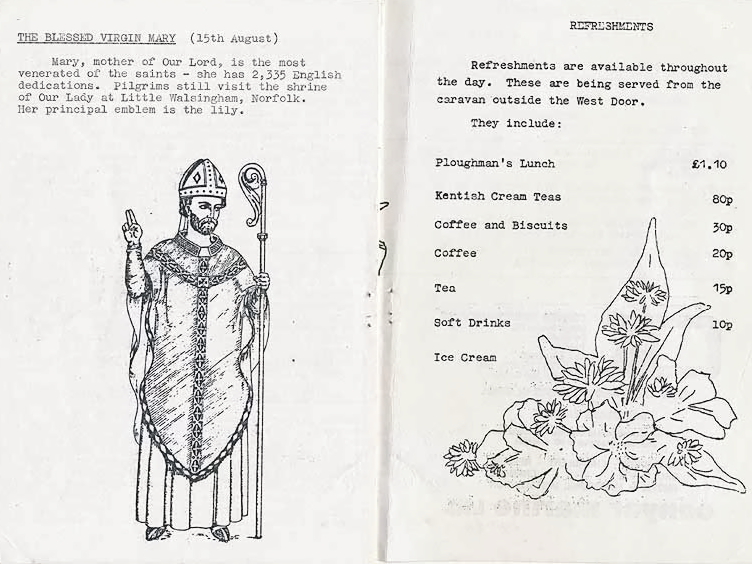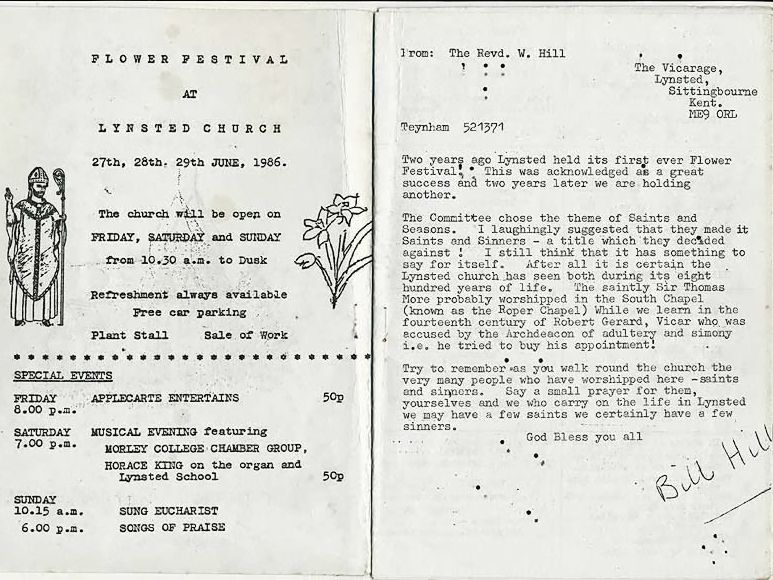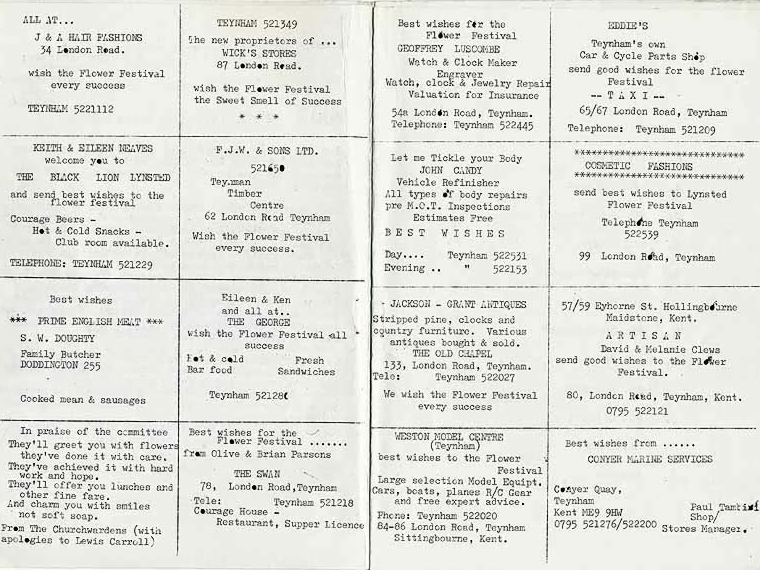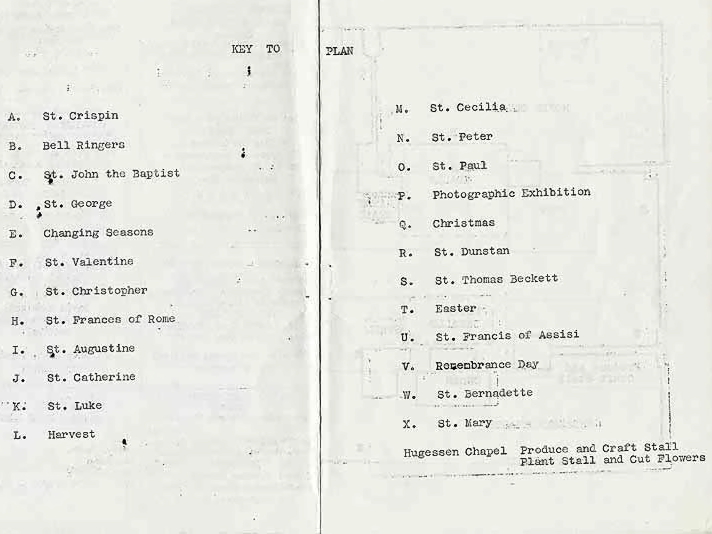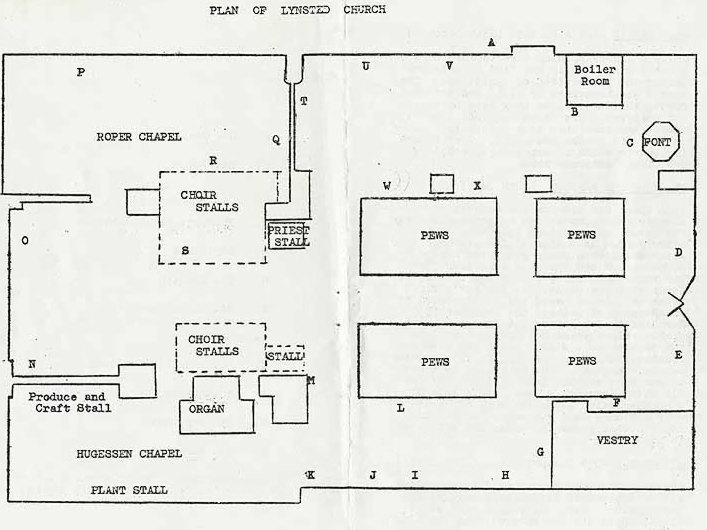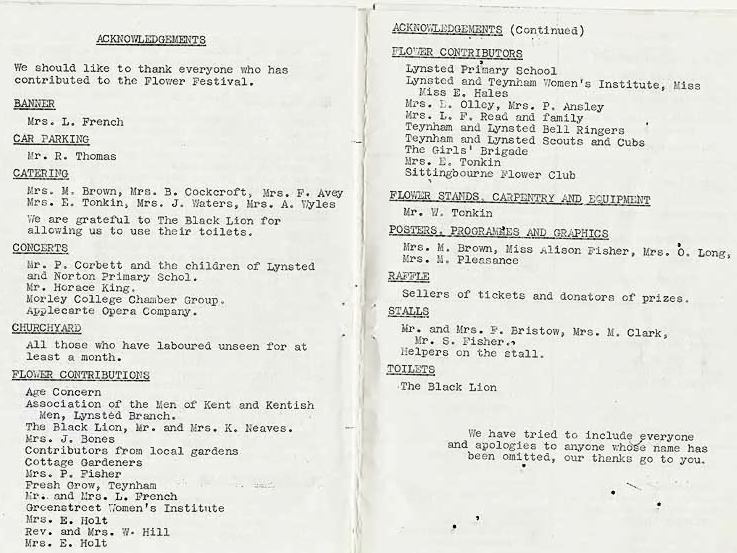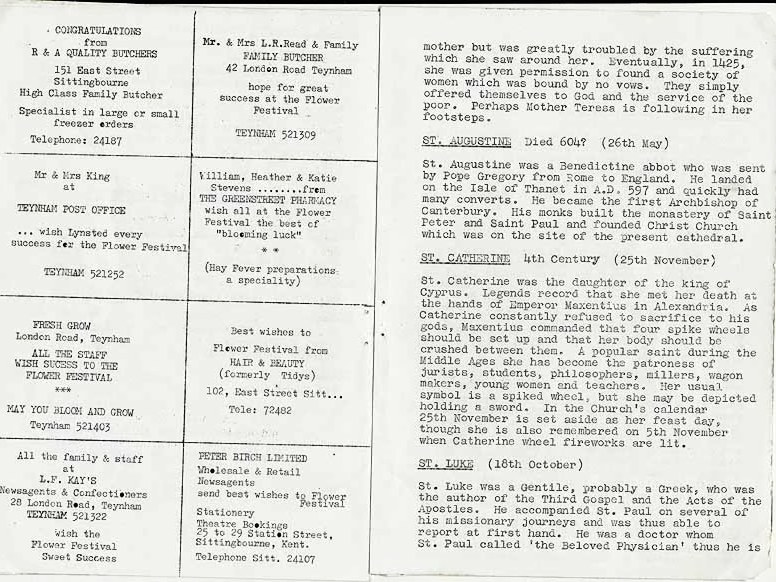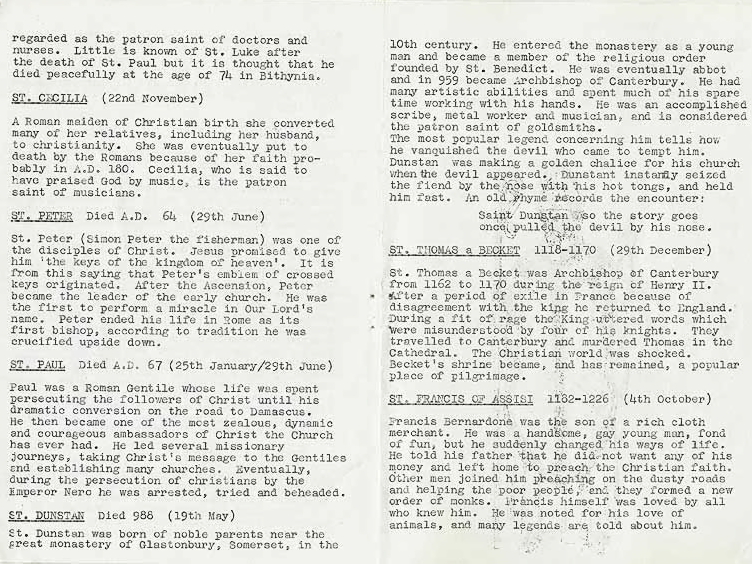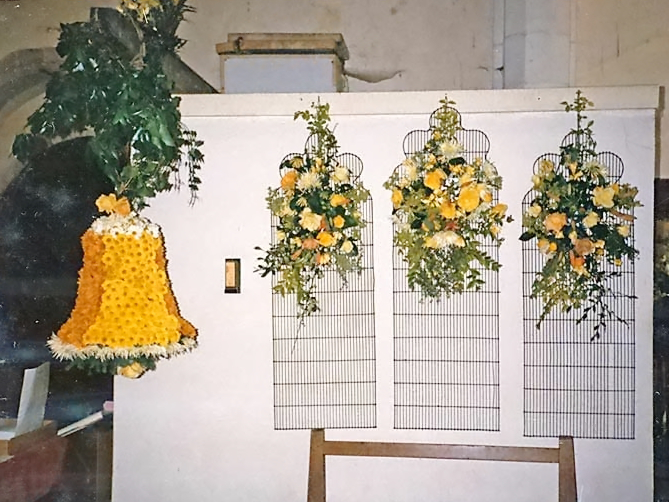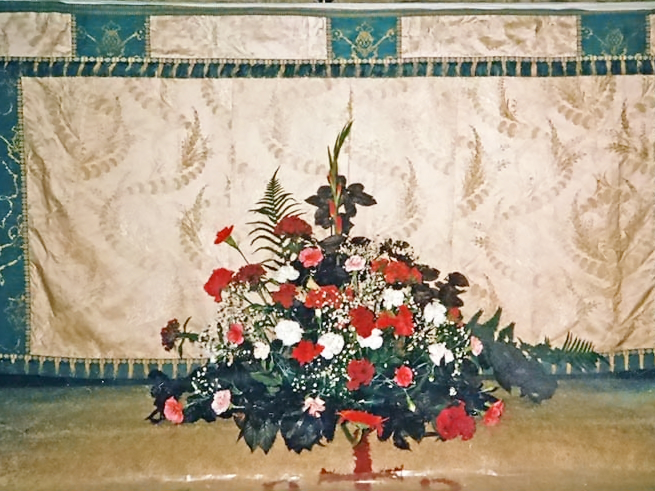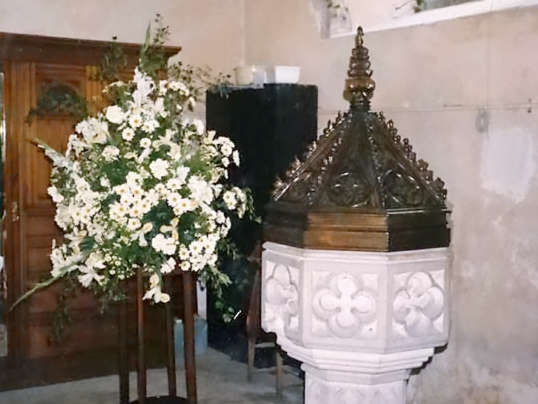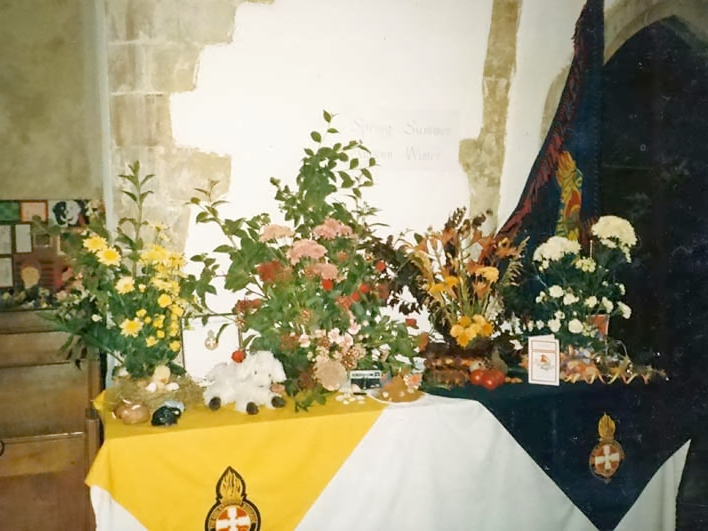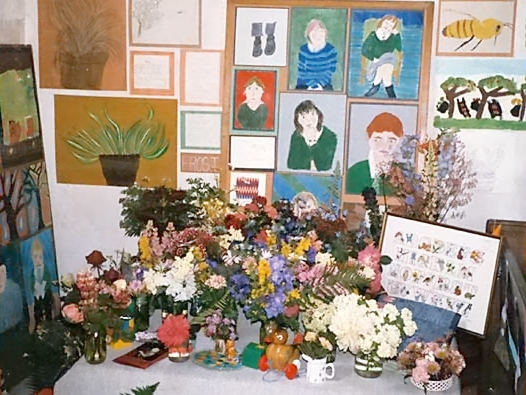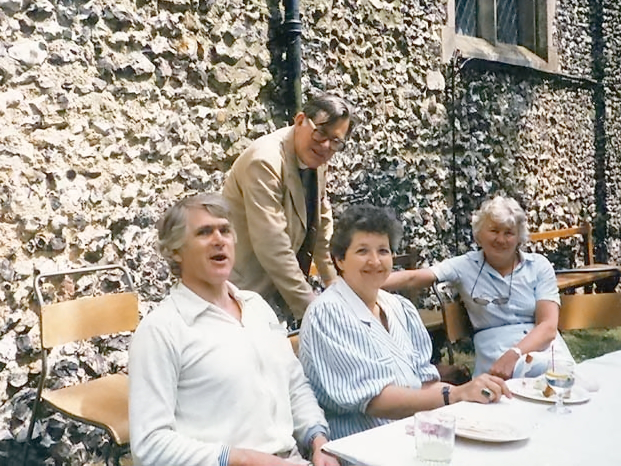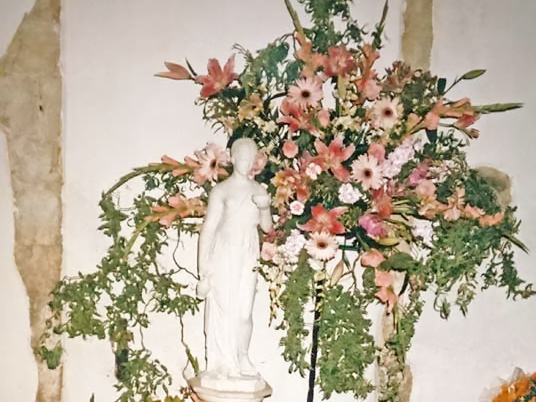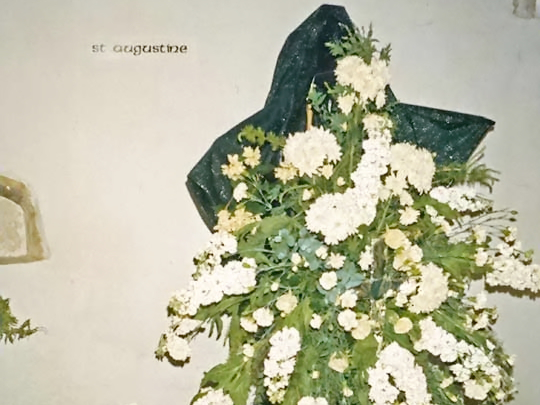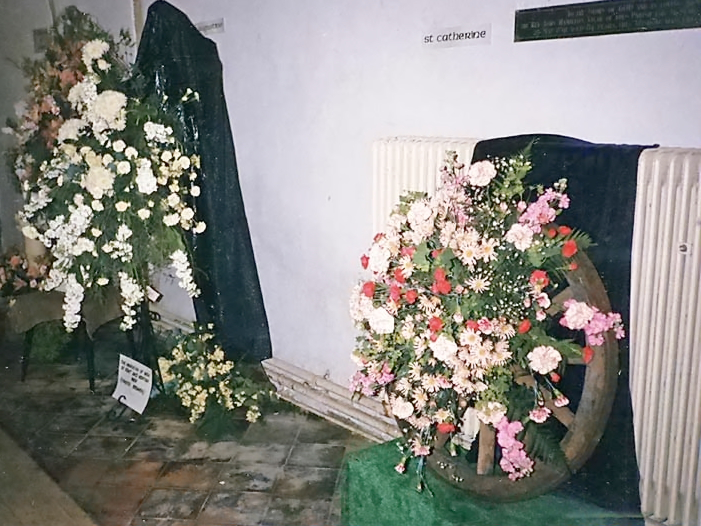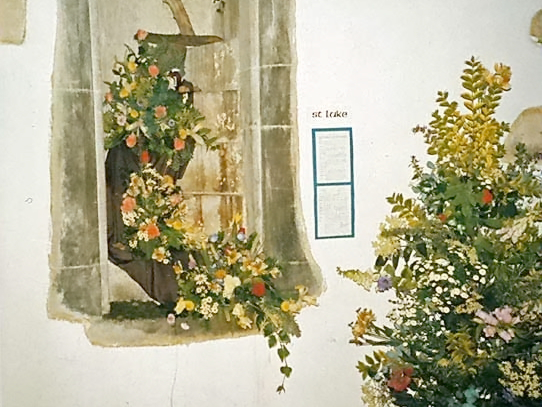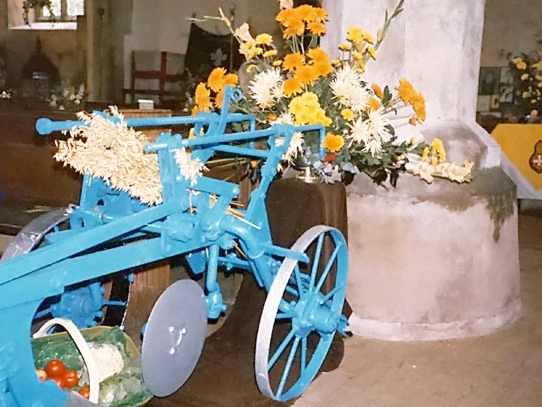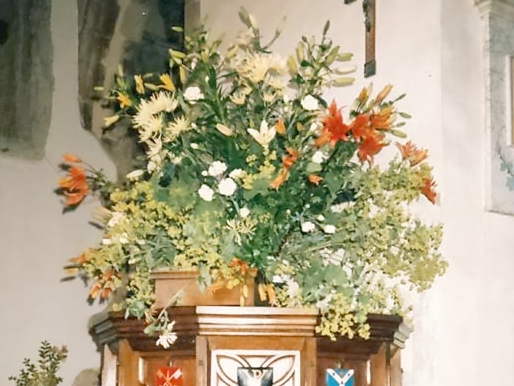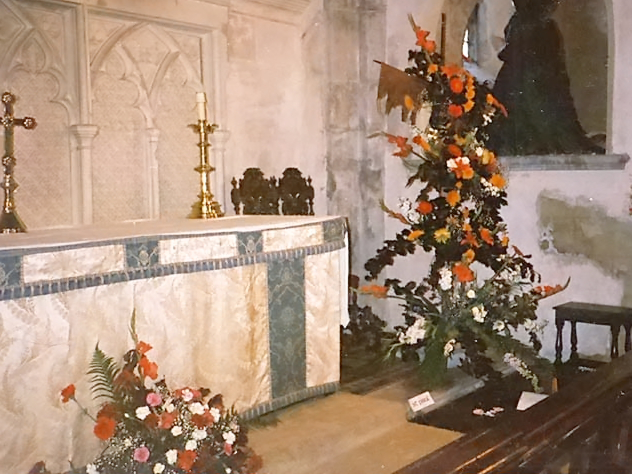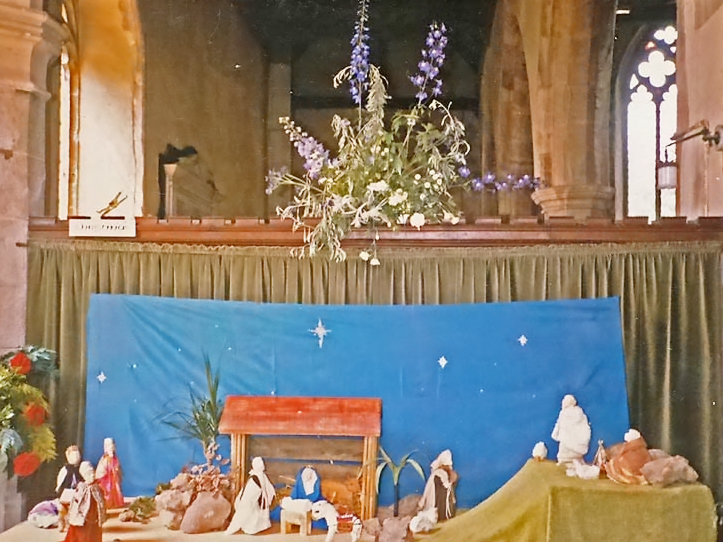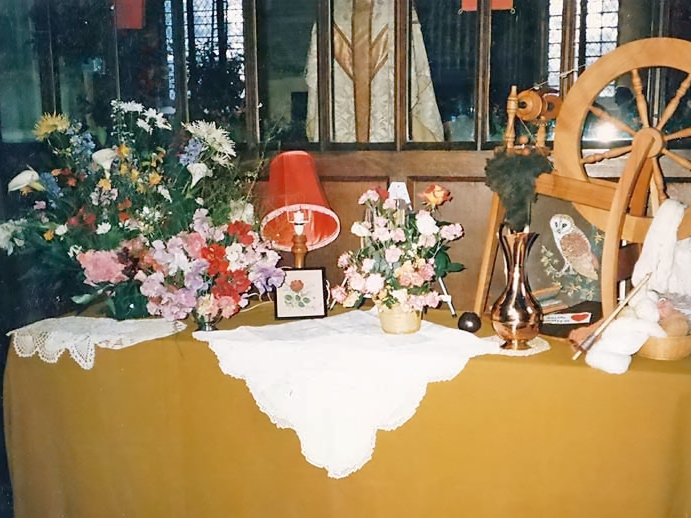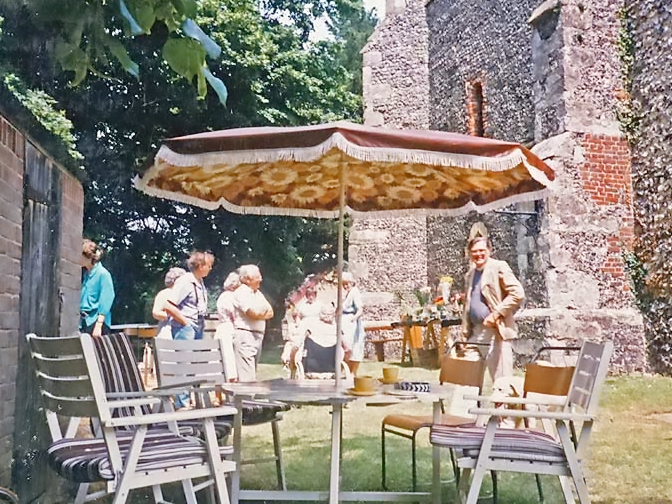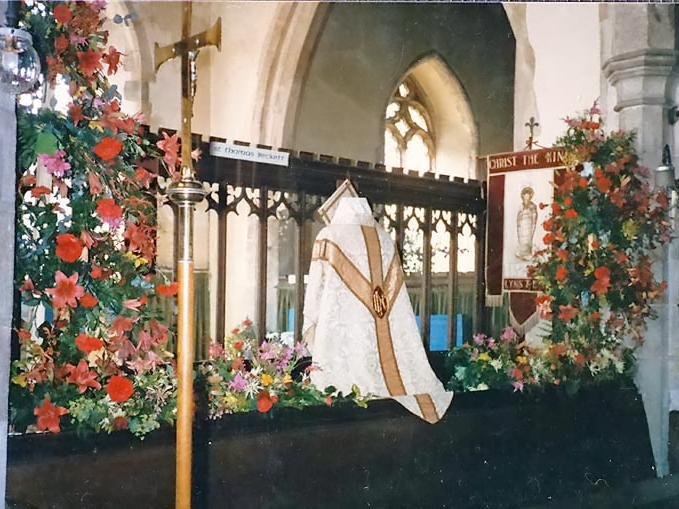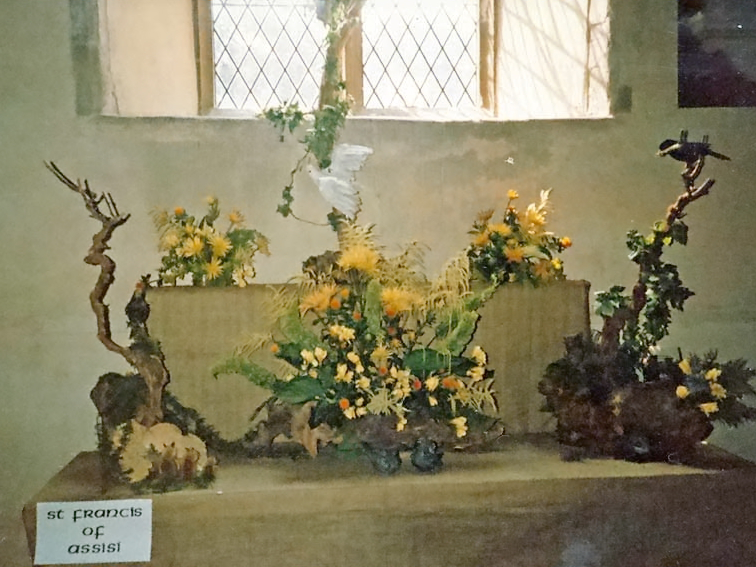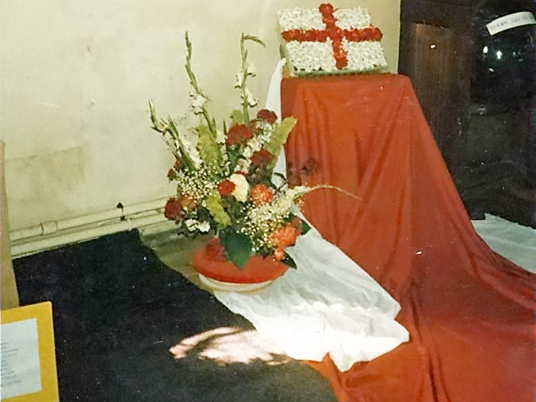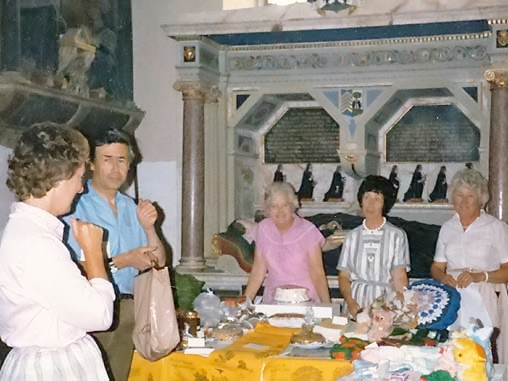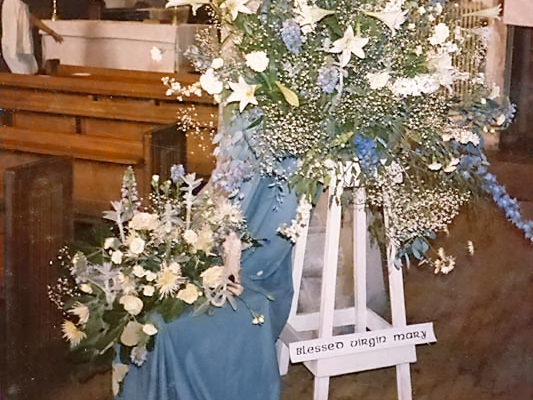Lynsted Church Flower Festivals - 1986 - "Saints and Seasons".
NOTES ON SAINTS AND SAINT'S DAYS
ST.CRISPINS - Died A.D. 285 (25th October)
Crispin and Crispinian were two brothers of a noble Roman family who fled to Soissons during the persecution of Christians. They worked as shoemakers by night and preached during the day. Later they were betrayed and martyred. Tradition connects them with Faversham where they took refuge in a house on the site of the Swann Inn. They became the patron saint of shoemakers, cobblers and other leatherworkers.
ST. JOHN THE BAPTIST (24th June)
John spent his time in the desert, an ascetic, his purpose was to prepare the way for Jesus. He baptised followers in the River Jordan as a sign of forgiveness. He was humbled when Jesus requested baptism as he recognised Him as the Messiah. He was imprisoned for publicly criticizing his marriage to Herodias, his brother's wife. Later at a feast Herod was so impressed by the dancing of Salome, the daughter of Herodias that he offered to grant her one wish. Salome asked for the head of John the Baptist on a dish. Sadly her wish was granted. St. John the Baptist is a popular saint in England. The reference he makes to our Lord as "The Lamb of God" provides him with a symbol, a lamb. This made his a popular saint among the wool merchants of the Middle Ages and many churches in the old wool producing areas are dedicated to him.
ST.GEORGE - 3rd Century A.D. (23rd April)
The legend of St. George told by crusaders was of a terrible dragon that ravaged the countryside. Each day people were sacrificed, until the day arraived when the King's daughter was to be the next victim. George fought and slew the dragon with God's help. Many became Christians. St. George became Patron Saint of England.
ST. VALENTINE - Died A.D. 270 (14th February)
Valentine is thought to have been a Roman priest who was arrested and beheaded for refusing to denounce his faith during the persecution which raged during the reign of Claudius II. The custom of choosing 'valentines' on 14th February probably arose because it was believed that "every bird chooseth him a mate" on that day.
ST. CRISTOPHER - Died A.D. 250 (25th July)
The name Christopher comes from the Greek and means Christ bearer. A man of giant size and strength Christopher promised to serve only a master stronger than himself and without fear. he left the service of the King of Palestine when he realised that he was afraid of the Devil. When he discovered that the Evil One trembled at the sight of a cross by the wayside he at once left him to find and serve the unknown one whose images he had seen on the cross. Having been baptised by a hermit he served his Master by carrying travellers across the broad river, on his shoulders. One day he carried a child, but with every step he took the child became heavier and heavier until the giant staggered under the weight. The child was Christ. Christopher was martyred during the persecution of the Christians by the Roman Emperor Decius. he is a popular saint with motorists and other travellers. The spacemen who circled the moon on Apollo 8 carried St. Christopher emblems with the.
ST.FRANCES OF ROME - 1384-1440 (9th March)
Born of wealthy parents in Rome, Frances was attracted to the religious life during her youth. Her parents objected and she was forced to marry a young nobleman. She was an exemplary wife and mother but was greatly troubled by the suffering which she saw around her. Eventually, in 1425, she was given permission to found a society of women which was bound by no bows. They simply offered themselves to God and the service of the poor. Perhaps Mother Teresa is following in her footsteps.
ST. AUGUSTINE - Died 604? (26th May)
St. Augustine was a Benedictine abbot who was sent by Pope Gregory from Rome to England. He landed on the Isle of Thanet in A.D. 597 and quickly had many converts. He became the first Archbishop of Canterbury. His monks built the monastery of Saint Peter and Saint Paul and founded Christ Church which was on the site of the present cathedral.
ST.CATHERINE - 4th Century (25th November)
St. Catherine was the daughter of the king of Cyprus. Legends record that she met her death at the hands of Emperor Maxentius in Alexandria. As Catherine constantly refused to sacrifice to his gods, Maxentius commanded that four spike wheels should be set up and that her body should be rushed between the. A popular saint during the middle Ages she has become the patroness of jurists, students, philosophers, millers, wagon makers, young women and teachers. Her usual symbol is a spiked wheel, but she may be depicted holding a sword. In the Church's calendar 25th November is set aside as her feast day, though she is also remembered on 5th November when Catherine wheel fireworks are lit.
ST. LUKE (18th October)
St. Luke was a Gentile, probably a Greek, who was the author of the Third Gospel and the Acts of the Apostles. He accompanied St.Paul on several of his missionary journeys and was thus able to report at first hand. he was a doctor whom St.Paul called 'the Beloved Physician' thus he is regarded as the patron saint of doctors and nurses. Little is known of St. Luke after the death of St.Paul but it is thought that he died peacefully at the age of 74 in Bithynia.
ST. CECILIA (22nd November)
A Roman maiden of Christian birth she converted many of her relatives, including her husband, to Christianity. She was eventually put to death by the Romans because of her faith probably in A.D.180. Cecelia, who is said to have praised God by music, is the patron saint of musicians.
ST. PETER - Died A.D.64 (29th June)
St.Peter (Simon Peter the fisherman) was one of the Disciples of Christ. Jesus promised to give him 'the keys of the kingdom of heaven'. It is from this saying that Peter's emblem of crossed keys originated. After the Ascension, Peter became the leader of the early church. He was the first to perform a miracle in Our Lord's name. Peter ended his life in Rome as its first bishop, according to tradition he was crucified upside down.
ST. PAUL - Died A.D.67 (25th January/29th June)
Paul was a Roman Gentile whose life was spent persecuting the followers of Christ until his dramatic conversion on the road to Damascus. He then became one of the most zealous, dynamic and courageous ambassadors of Christ the Church has ever had. He led several missionary journeys, taking Christ's message to the Gentiles and establishing many churches. Eventually, during the persecution of Christians by the Emperor Nero he was arrested, tried and beheaded.
ST. DUNSTAN - Died 988 (19th May)
St. Dunstan was born of noble parents near the great monastery of Glastonbury, Somerset, in the 10th century. He entered the monastery as a young man and became a member of the religious order founded by St. Benedict. He was eventually abbot and in 959 became Archbishop of Canterbury. He had many artistic abilities and spent much of his spare time working with his hands. He was an accomplished scribe, metal worker and musician, and is considered the patron saint of goldsmiths.
The most popular legend concerning him tells how he vanquished the devil who came to tempt him. Dunstan was making a golden chalice for his church when the devil appeared. Dunstan instantly seized the fiend by the nose with his hot tongs, and held him fast. An old rhyme records the encounter:
Saint Dunstan so the story goes
once pulled the devil by his nose.
ST. THOMAS a BECKET - 1118-1170 (29th December)
St. Thomas a Becket was Archbishop of Canterbury from 1162 to 1170 during the reign of Henry II. After a period of exile in France because of disagreement with the king he returned to England. During a fit of rage the King uttered words which were misunderstood by four of his knights. They travelled to Canterbury and murdered Thomas in the Cathedral. The Christian world was shocked. Becket's shrine became, and remained, a popular place of pilgrimage.
ST. FRANCIS OF ASSISI - 1182-1226 (4th October)
Francis Bernardone was the son of a rich cloth merchant. He was a handsome, gay young man, fond of fun, but he suddenly changed his ways of life. He told his father that he did not want any of his money and left home to preach the Christian faith. Other men joined him preaching on the dusty roads and helping the poor people, and they formed a new order of monks. Francis himself was loved by all who know him. He was noted for his love of animals, and many legends are told about him.
THE BLESSED VIRGIN MARY (15th August)
Mary, mother of Our Lord, is the most venerated of the saints - she has 2,335 English dedications. Pilgrims still visit the shrine of Our Lady at Little Walsingham, Norfolk. Her principal emblem is the lily.
Newspaper Reports
4 June 1986 (Found by Jean Waters)
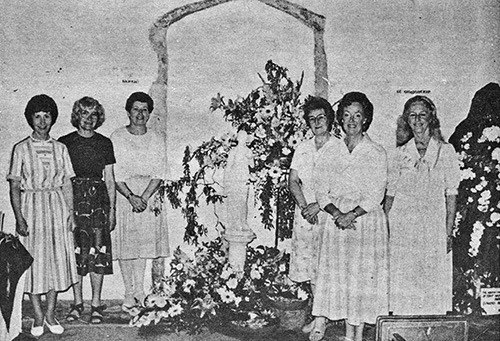
LYNSTED Church was filled with floral treasures at the weekend as the parish hosted its second flower festival.
But to look at the standard of the displays you'd have thought the parishioners had been doing it for years.
The theme, "Saints and Seasons" sparked imagination in all corners of the village.
Each exhibit was constructed with meticulous care and remarkable detail.
And almost every section of the community submitted an exhibit to the church - from the pub to the doctor's surgery.
Good signposting and the balmy weekend weather must have contributed largely to the £1,200 raised for church restoration funds.
The theme was decided upon after a representation from the vicar, the Rev Mr Bill Hill who felt that the festival might be more appropriately entitled "Saints and Sinners".
"We may have a few saints in Lynsted and we certainly have a few sinners," he mused.
HISTORY
As well as the flower festival to enchant visitors, there was the historical side of the church which in days gone by has boasted links with Charles II and Sir Thomas More.
The mausoleum was open throughout the weekend for those who could pluck up the courage to enter its eerie confines.
There were about 30 floral exhibits inside the church.
- There was also a produce and craft stall and plant stall with cut flowers situated in the Huggessen Chapel.
- Among the most impressive of the exhibits was that portraying St Francis of Assissi.
- The patron saint of animals was depicted by a woodland setting with a mass of colourful flowers set in tree bark and enhanced by woodland animals delicately modelled from fir cones and other natural products.
- The stone steps of the Roper Chapel were filled with bloom courtesy of Pam Ansley and Elaine Olney receptionists at the doctor's surgery.
- Their display of more than 20 medicinal plants in a spiraling arrangement featured eucalyptus, rosemary and asparagus, all plants used for healing purposes.
- The local bellringing society presented a floral cluster in the shape of a bell.
And one exhibit which really caught the eye was Marlene King and Celia Reynolds' dramatic floral appreciation of St Peter.
- Flowers clustered beneath the twisted debris of a wrecked ship brought back memories of RE lessons.
- The Black Lion pub chose St Catherine as their theme.
- Eileen Neeves and Phyllis Payne, regulars at the pub, mounted a superb arrangement of pink carnations and other flowers upon a rustic I cartwheel.
- Pearl Fisher was responsible for decorating the pulpit.
- Her meandering arrangement of orange and yellow flowers also depicted St Cecilia, the patron saint of music.
- An array of white carnations and roses set against the background of a monk's habit were submitted by the Association of the Men of Kent and Kentish Men, Lynsted branch.
- Turning to the seasons, decorations for Christmas and Easter were submitted by Leslie and Lynn French of Batteries Farm, Lynsted.
- There were other exhibits from the Lynsted and Teynham WI, Teynham and Lynsted Scouts and Cubs, Sittingbourne Flower Club, the Girls Brigade and Age Concern.
- Floral sprays at the end of each congregational pew were arranged by Eileen Tonkin.
- And pupils of Lynsted and Norton Primary School put on an art exhibition on the Saints and Seasons theme.
Funds were bolstered by concerts on Friday and Saturday evening by Apple Cart and the Morley College Chamber Group aided by Horace King on the organ and pupils of Lynsted School.
The weekend was rounded off with a Songs of Praise of Sunday evening.
Mrs Celia Reynolds, a member of the Lynsted Flower Festival Committee said: "The standard of exhibits at this year's festival has outshone that of two years ago, when we had our last show. And more people have taken part this year, which makes it less of a task for us, the organisers. Just about everyone it seems has wanted to be involved."
Blooms and tunes create church festival success
Flowers, teas and music combined with the glorious weather to make Lynsted Flower Festival at the week¬end a great success.
The church was filled with flower arrangements on the theme "Saints and Seasons" and there was a steady flow of visitors to admire the results of the, hard work put in.
On Friday evening, light opera group Applecarte gave a concert and the following evening church "organist Horace King was joined by the Morley College Chamber Choir. The concert was rounded off by youngsters from Lynsted and Norton School performing old music hall songs dressed in period costume.
Over the week-end, refreshments were served in the churchyard and Mrs. Pearl Fisher, one of the organizers, said it was like a garden party.
"We were very happy with everything," she said. "There was a wonderful atmosphere and it was a very fulfilling thing to be involved in."
The final amount raised is not yet known, but all profits will go to church funds.
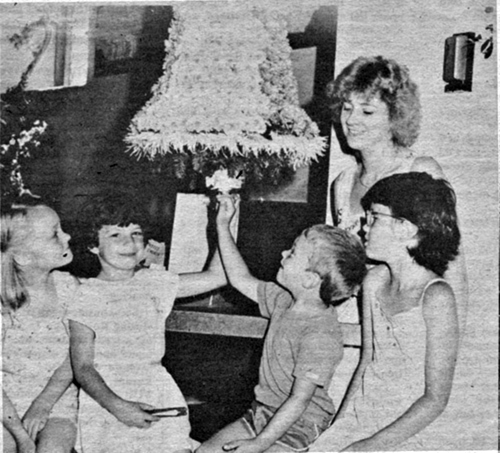
Caption: Admiring this beautiful floral bell are (from left) Kate Oyler, Charlotte Neaves, Thomas Oyler and Victoria Neaves, with bell-ringer Gillian Brown, who made the display.

